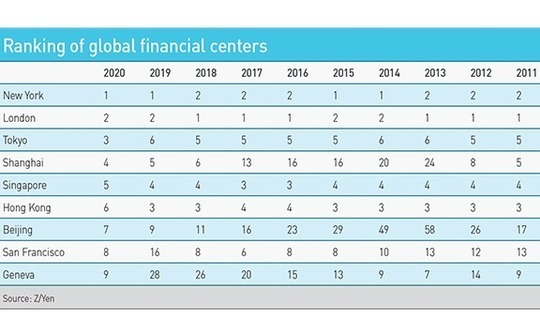
Hong Kong vs Singapore: Onshore overtures

Hong Kong and Singapore both position themselves as the headquarters of choice for private equity firms in Asia. But the competitive dynamics – from politics to structures – are not straightforward
Did June 30 signal an imminent end to the tussle between Hong Kong and Singapore to become Asia's preeminent private equity hub?
Hong Kong was days away from passing an updated limited partnership law that would encourage GPs to domicile their funds in the territory, a significant step towards toppling the Cayman Islands hegemony by aligning every facet of the management process in a single onshore jurisdiction. Singapore – which was already trying to consolidate its lead in this area with the launch of a new super-flexible structure, the variable capital company (VCC) – would face a credible threat.
Then Hong Kong's national security law intervened. It was no secret that the legislation would criminalize secession, subversion, terrorism, and collusion with foreign powers, but the scope of application implied by the wording prompted widespread concern. The international community condemned it for undermining existing agreements on the governance of Hong Kong. Many locals started examining emigration options, fearing an irrevocable erosion of civil liberties. Surely business would follow, with Singapore waiting to engulf private equity firms in its commercial embrace.
"The official line is it doesn't change anything. We are fully committed to Hong Kong and it's a natural place for doing business. And the reality behind that response is many private equity firms do a chunk of their business in China, so they can't speak out about problems," says one longstanding industry participant. "The unofficial position is that, for a lot of deal doers, China will remain a very important market, and Hong Kong is a logical base of operations. But behind that is a sense that a bunch of the back-office type jobs will quietly migrate."
This is one of multiple views in a highly politicized and sensitized debate. While there are accounts of fund managers beating a path to the exit, AVCJ found little evidence of this within the private equity industry. Wait-and-see appears to be the default position.
Moreover, the Hong Kong versus Singapore sub-plot is not as binary as it might seem. Deciding where to deploy human resources within the region is one thing; picking a fund domicile is another entirely, driven by the size and strategy of the manager and the experience and geographic origins of the LP base. Even if it did come down to a choice between Hong Kong and Singapore – not an inconceivable very long-term outcome – placing the former's limited partnership structure against the latter's VCC represents a failure to appreciate the nuances of each one.
"I get people from overseas saying [the security legislation] doesn't look good, but they have been primed by news coverage, they don't necessarily have an independent opinion on the options facing Hong Kong. Some people are thinking about how they would react in a pessimistic scenario and what actions they can take now," says Andrew Read, a Hong Kong-based partner at fund administrator Langham Hall.
He adds that there hasn't been a discernable migration to Singapore among his clients, but many have operations in both locations.
Wait and watch
Chief among the reasons for taking a patient and watchful approach is there's so much about the national security law that is unknown.
According to Kent Kedl, a Greater China-focused partner at Control Risks, a specialist global risk consultancy, the writing is very much in a mainland regulatory style rather than a Hong Kong common law style. It offers detail on the penalties and mechanisms of enforcement, but there is little definition of the various crimes. People know what will happen if they transgress; they don't necessarily understand what constitutes a transgression.
Control Risks is getting questions from clients about how changes in Hong Kong could impact their business in the medium term, not the relocation of operations. While Kedl accepts that concerns about data security are legitimate – hence the recent moves made by global technology companies – he does not believe the legal and corporate infrastructure that underpins business is under threat. Rather, it is in Beijing's interests to maintain the differences between Hong Kong and the mainland.
"However, it's had a chilling effect on people's willingness to live in Hong Kong. The perception might be that it's not as welcoming a place to live as before," Kedl adds. "Companies will be asking whether they can recruit and retain people there. That will be a bigger concern than the specific application of the national security law."
This explains the somewhat personal nature of the responses within the private equity industry thus far. A Hong Kong-based headhunter observes that he has just one live project involving operational relocation: a private equity firm is moving its headquarters to Singapore and wants to hire a COO. Meanwhile, various professionals are keen for a change of scene for family reasons, often those with school-age children. This trend emerged last year as the Hong Kong protests intensified.
Other industry participants tell similar stories. Individuals might be contemplating moves; their employers are quietly figuring out the ramifications of the law and reviewing contingency plans. This may involve exploratory talks with service providers in other jurisdictions. Some reallocation of resources a few months down the line to achieve greater regional diversification wouldn't come as a shock, especially among international firms that already have multiple offices.
As for Hong Kong's limited partnership law, which will come into force at the end of August, initial take-up is expected to be reasonably brisk. Mainland Chinese managers looking to raise US dollars offshore were always tipped as the early movers. They are unlikely to be put off by the national security law (they are already subject to a version of it); many will be encouraged by a familiarity with Hong Kong; and some already have offices there.
"The first wave will be Chinese managers," says Anthony Lau, a Hong Kong-based tax partner with Deloitte. "We have already received a lot of queries from clients who are interested in this new regime due to changes in Cayman's private fund law and the economic substance requirements."
Under pressure from the Organization for Economic Cooperation & Development (OECD) to comply with international standards – and stop investors artificially shifting profits to low or no-tax jurisdictions – Cayman recently announced that private funds must be registered and more closely monitored, including an annual audit signed off by a local regulator. Last year, regulators decreed that most fund management entities must demonstrate local substance, prompting a host of private equity firms to relocate these entities to Hong Kong. Now their funds could follow.
The motivating factors are reputation, practicality, and cost. Some LPs are no longer comfortable investing in Cayman-domiciled funds, while a growing number of Asian GPs are not convinced the jurisdiction has enough local talent to handle these new compliance requirements or they don't want to bear the additional financial burdens of compliance.
"There are Chinese financial institutions that have all sorts of needs: blind pool funds, project funds, co-investment funds. For smaller deals, setting up and maintaining a Cayman structure is becoming expensive. If the management team and advisory entity are in Hong Kong, and the firm has the right licenses, why not establish the fund here as well?" says Lorna Chen, a Hong Kong-based partner at law firm Shearman & Sterling.
"The costs will be lower because they only need one set of lawyers, accountants and other service providers, and they don't have to travel outside Hong Kong."
Going global
There was a conscious effort to make the Hong Kong limited partnership structure like that of Cayman and faciliate migration from one to the other. For example, while financial and shareholder information on listed companies is publicly available under the registrar system, this does not apply to private funds. And then a profits tax exemption is available at the fund level if certain conditions are met.
Double taxation agreement (DTA) benefits are another incentive to come onshore. Hong Kong's inland revenue department (IRD) is reluctant to issue local tax residency certificates – necessary for DTA access – to special purpose vehicles (SPVs) through which funds make investments. Deloitte's Lau suggests this position might change if the entire investment structure is onshore. "We hope the IRD will take a more pragmatic approach to looking at substance on a holistic basis," he says.
International managers, however, will be a much harder sell than their Chinese counterparts. While there is some suggestion of Hong Kong losing ground to Singapore because of the political situation, an established manager might not choose either as a fund domicile.
"Changing the structure investors subscribe to is a big deal," says Adam Williams, Greater China PE tax leader at EY. "Say you're a big-name fund, you've used Cayman for your last four funds and you're marketing your fifth. Your law firm is reviewing the limited partnership agreement, you've got comments coming back from LPs, and then you say you want to use a corporate structure with a legal agreement that looks different. The lawyers would have to review it from scratch."
Some global private equity firms will be happy continuing with Cayman because they have the resources to establish local substance. If not, Delaware, British Columbia and Luxembourg might be prioritized over Asian jurisdictions by managers with international LP support, suggests Read of Langham Hall. GPs don't want to spend time explaining their fund structures that would otherwise be devoted to marketing their funds.
One fund manager, who uses Cayman, recalled asking his advisors whether there was any good reason for choosing a VCC for his latest fund. They couldn't give one. "Also, no one could give me a definitive answer as to whether a VCC would be treated as a Singapore resident vehicle for investments in Indonesia," he adds. "I don't want to tell the partnership three years' down the road, ‘We didn't check this when we set up the fund, and sorry, you have to pay tax.'"
It remains to be seen how quickly GPs outside of Greater China and Southeast Asia, respectively, turn to the Hong Kong limited partnership or Singapore VCC. Sum Tze Sheng, country executive for Singapore at fund administrator Alter Domus, observes that it took about eight years for the Singapore limited partnership to become accepted by international LPs. And it is only in the last three years that managers have stopped trying to gauge comfort levels.
It is worth noting that the structure is used in different ways. Several industry participants say they most frequently see Singapore limited partnerships as pooling vehicles below feeder funds located in jurisdictions like Cayman, so the LP experience is little changed.
Singapore has proved a popular destination for regional platforms that sit in between master or feeder funds and the SPVs used to make investments, especially in Southeast Asia and India. Managers must commit to at least S$200,000 ($143,000) in local business spending a year – essentially establishing substance – but in return, they are regulated, exempted from tax at the fund level, and have access to the country's DTA network.
Look and leap
VCCs are also likely to have a variety of use cases, not least because they are designed for multiple asset classes. A total of 78 had been registered as of June. They include a $20 million fund launched by Latin Leap, a Colombian VC investor and start-up services provider. Its objective is to help Southeast Asian companies expand into Latin America.
Asked why he opted for the structure, Stefan Krautwald, a general partner at Latin Leap, notes that prospective LPs had little appetite for Cayman. Even among Latin American investors, which boast geographic proximity to the jurisdiction, not one recommended using it. The other reason was tied to Latin Leap's remit.
"We are connecting Southeast Asia with Latin America and we have found a great partner in the Singapore venture capital ecosystem alongside government agencies. It was a natural choice to line up our legal structure in Singapore rather than going through a third-party location that wasn't necessarily connected to the regions we want to connect on the technology side," he explains, adding that most of the fund corpus will likely come from Southeast Asian LPs.
Relatively modest fund sizes and a reliance on local money is a common theme among the current cohort of VCCs. Most of them are not private equity players. The list released by the Monetary Authority of Singapore (MAS) is heavy on hedge funds, with a sprinkling of family offices and VC. Ryan Lin of Zico Law, who set up the Latin Leap structure, claims to have worked on six VCCs in total for hedge fund and venture capital clients. He notes that PE firms are warier of the structure.
Others in the service provider community claim to have received interest from across the alternatives spectrum. Within private equity, Indian managers looking to establish a presence in Singapore are frequently mentioned. The larger names tend to come from real estate and credit. Often money is a motivating factor. The MAS is currently running a grant scheme that covers up to 70% of the legal and other fees incurred during setup, capped at S$150,000 per VCC.
"For a lot of the people I'm speaking to about using a VCC, the first thing they ask is how they can qualify for a grant," says Sheng of Alter Domus. "For hedge funds and family offices with less than $50 million in assets under management, S$150,000 goes a long way."
Umbrella option
Beyond that, the VCC is described as a deliberately flexible structure intended to fill in some of the gaps in Singapore's product offering. For example, there are headaches around using a corporate structure as a fund or pooling vehicle. First, records are publicly accessible. Second, it is difficult to make dividend payments unless the structure if profitable or has a net asset positive position. The VCC comes with a lighter compliance burden.
In addition, the VCC can deliver substantial cost savings because it allows multiple sub-funds and share classes to be established as an umbrella structure. The assets and liabilities of the different sub-funds are segregated, which means managers needn't pay lawyers to draw up a new set of documents every time they want to explore a new strategy.
In Cayman – where the equivalent structure is a segregated portfolio company (SPC) as opposed to a fund – a single bank account covers all sub-funds, so protracted know-your-customer (KYC) and anti-money laundering (AML) processes can be avoided.
However, SPCs are popular among financial institutions that want to bundle up co-investments and project funds; they are seldom used by mainstream GPs. "The structure has its limitations," adds Shearman's Chen. "Even in Delaware where there is a similar legal concept, it is legally untested that courts in other jurisdictions would recognize the separation of liabilities. Sophisticated sponsors and LPs are hesitant to use this structure. They prefer standard GP-LP structures."
This goes to the heart of the acceptance issues around VCCs. Even though there is good reason for Singapore pursuing flexibility and a corporate structure specifically – it is difficult for limited partnerships to access DTAs directly – investors are being moved outside their comfort zone.
"There are not a lot of differences between the limited partnership and the VCC conceptually, it's more about investor familiarity," says Wee Hwee Teo, head of real estate and asset management tax at KPMG in Singapore. "Often, I have to remind clients that the VCC is a corporate fund structure. It doesn't help that Singapore is a new fund domicile compared to Cayman, Luxembourg, and Jersey."
Teo claims to have seen increased demand for Singapore limited partnerships in recent years. Some of this comes from private equity firms based in Japan and South Korea that have no local presence, so cannot qualify for the VCC. They are establishing pass-through vehicles in Singapore because it is cheaper than Cayman. Others want local substance and tax benefits; they just don't want a VCC.
Scott Peterman, a Hong Kong-based partner at law firm Orrick, puts it bluntly: "I don't think the VCC is an appropriate tool for a PE or VC fund. If you look around the world, Japan, Latin America, the US, Canada, Luxembourg, Ireland, and the UK, they all use partnerships. I think VCCs appeal to people not so much because of the flexibility but because they are perceived to be document-light and cheap. It's concerning because those are the people most likely not to be attentive to some of the legal nuances around sub-funds and share classes."
The long game
Clearly, it will take time for Hong Kong and Singapore to build up confidence in their relatively new structures, regardless of what function these entities perform within a fund management operation.
Macro trends appear to favor Asia's onshore jurisdictions. First, the long-term viability of making investments through local corporate structures or SPVs from funds located elsewhere is routinely questioned. While it works for now with a certain level of local substance, regulators in target countries might ultimately decide that the substance is insufficient, pierce through the structure up to the fund level, and deny DTA benefits.
Second, a new breed of investor is emerging, often within the region, that is not wedded to the traditional structures and jurisdictions.
Nevertheless, Hong Kong and Singapore have regulatory issues of their own to resolve, most notably the treatment of carried interest. Following the IRD's declaration that carry received outside Hong Kong could be taxed onshore – at the corporate or individual level – as income rather than capital gain, the Hong Kong government has promised to deliver a commercially viable solution. Singapore, for its part, treats carry as capital gain, which means zero tax, and is officially silent on the issue.
Fund domicile has little bearing on the taxation of carried interest; under the IRD's proposal, Hong Kong-based managers would have to pay up regardless of where their fund is located. But establishing a fund in a particular jurisdiction places a private equity firm in the crosshairs of the revenue department.
Certainty of treatment, and the attractiveness of that treatment, could prove decisive in discussions about where to put people, money, and infrastructure. For Hong Kong, it could help offset any lingering concerns about the national security law.
"If Hong Kong provided certainty on carried interest in conjunction with the new limited partnership law that in my view could be the killer app," says Gavin Anderson, a partner at law firm Debevoise & Plimpton. "If the question is, ‘Do I use Cayman, Canada, Delaware or Hong Kong?' and Hong Kong comes up with a deal on carried interest that is more attractive than the current situation, that would be great."

Latest News
Asian GPs slow implementation of ESG policies - survey
Asia-based private equity firms are assigning more dedicated resources to environment, social, and governance (ESG) programmes, but policy changes have slowed in the past 12 months, in part due to concerns raised internally and by LPs, according to a...
Singapore fintech start-up LXA gets $10m seed round
New Enterprise Associates (NEA) has led a USD 10m seed round for Singapore’s LXA, a financial technology start-up launched by a former Asia senior executive at The Blackstone Group.
India's InCred announces $60m round, claims unicorn status
Indian non-bank lender InCred Financial Services said it has received INR 5bn (USD 60m) at a valuation of at least USD 1bn from unnamed investors including “a global private equity fund.”
Insight leads $50m round for Australia's Roller
Insight Partners has led a USD 50m round for Australia’s Roller, a venue management software provider specializing in family fun parks.








